Ski: 2021-2022 Atomic Backland 107, 182 cm
Test Locations: Crested Butte & Berthoud Pass, CO
Days Skied: 10
Available Lengths: 175, 182, 189 cm
Blister’s Measured Tip-to-Tail Length: 181.4 cm
Stated Weight per Ski: 1550 grams
Blister’s Measured Weight per Ski: 1643 & 1663 grams
Stated Dimensions: 137-107-124 mm
Blister’s Measured Dimensions: 136.3-107.4-123.5 mm
Stated Sidecut Radius (183 cm): 18.5 meters
Measured Tip & Tail Splay (ski decambered): 56 mm / 19 mm
Measured Traditional Camber Underfoot: ~5 mm
Core: Karuba/Poplar + Carbon Stringers + Fiberglass Laminate
Base: Sintered
Factory Recommended Mount Point: -9.2 cm from center; 81.5 cm from tail
Boots / Bindings: Scarpa Maestrale XT & Tecnica Zero G Tour Pro / Atomic Shift MNC
[Note: Our review was conducted on the 19/20 Backland 107, which was reportedly not changed from the 18/19 model, apart from graphics. The Backland 107 also remains unchanged for 20/21 and 21/22, apart from graphics.]

Intro
The Atomic Backland 107 won the award for “most requested review” of the past year. Well, we finally have the ski in hand, so you can all stop flooding our inboxes with requests (just kidding, we appreciate the input).
This ski has been getting a lot of hype. And given that it effectively replaces Atomic’s very popular Backland FR 109 (and previously, the Automatic 109), that makes sense. So what is this new ski, and how does it compare to its predecessors and other skis on the market?
What Atomic says about the Backland 107
Atomic keeps things brief with their description of the Backland 107:
“The Atomic Backland 107 is a powder-charging backcountry ski – now featuring HRZN Tech in the tip for even more floatation.”
In their short description, Atomic chooses to emphasize the Backland 107’s powder performance. And specifically, they say it’s supposed to charge through powder, not just lazily play around through it. They also chose to classify it as a “backcountry” ski, and that seems sensible, given its weight (more on that later).
As for the talk about Atomic’s beveled-edge “HRZN Tech,” well, we’ll hold off on any conclusive statements until we ski the Backland 107. But after using the Atomic Backland FR 109, Bent Chetler 120, and Bent Chetler 100 (all of which feature HRZN Tech), we’re not ready to say that it makes a massive difference. But we’ll see if that changes with the Backland 107.
Shape / Rocker Profile
The Backland 107’s shape looks very similar to that of the Backland FR 109. For how wide it is, the Backland 107 has pretty moderate tip taper lines, and more significant tail taper compared to other skis in its class like the Black Diamond Helio 105, K2 Wayback 106, and Blizzard Zero G 105.
The Backland 107’s rocker profile is an aspect where it differs significantly from the Backland FR 109. The Backland 107’s tip rocker line is shallower, and rather than a gradual rise like the Backland FR 109’s tip rocker line, the Backland 107’s tip rises pretty abruptly (it’s fairly similar to the Atomic Bent Chetler 100 in this regard). In the tail, the Backland 107 has a shallower rocker line than the FR 109, and the Backland 107’s tail splay is much lower (19 mm vs. 45 mm). In other words, the Backland 107’s rocker profile is a bit more conservative than its predecessor’s, and it ditches the Backland FR 109’s twin tail for a much more subtle, lower tail rocker line.
Flex Pattern
Here’s how we’d characterize the flex pattern of the Backland 107:
Tips: 5.5-5
Shovels: 5.5-6.5
In Front of Toe Piece: 7-9
Underfoot: 9.5
Behind the Heel Piece: 9-7.5
Tails: 7.5-8.5
The Backland 107 has an interesting flex pattern. Its tips and shovels are very soft, but then it quickly stiffens up. And that section that’s very soft is really only where the tip is rockered and raised off the ground / snow. The middle of the ski is pretty strong without feeling “planky,” and the tail is much more supportive than the tip, but not super burly.
Compared to the Backland FR 109, the Backland 107 is softer in the tips, and maybe a touch stronger in the tail. Compared to the Line Vision 108, the Backland 107 is a bit softer at the very tips, but ramps up much quicker as you move to the middle of the ski, and finishes with a stronger tail. Compared to the Amplid Facelift 108, the Backland 107 is again a bit softer at the tip, ramps up a bit slower as you move from the tips to the center, but has a stronger tail. Compared to the new Blizzard Zero G 105, the Backland 107 is softer in the shovels and in the midsection, but has a slightly stronger tail.
Mount Point
The Backland 107’s recommended mount point is around -9.2 cm from center, which is fairly similar to the FR 109’s -8.5 cm, and falls in line with the mount points on more traditional / directional touring skis like the Black Diamond Helio 105, Blizzard Zero G 105, and K2 Wayback 106.
That said, we ended up liking the Backland FR 109 at a variety of mount points, including all the way up to -5 cm from center. So, we’ll be playing around with the mount point of the Backland 107 during our testing.
Weight
This is arguably the biggest difference between the Backland FR 109 and the Backland 107. Our pair of the 182 cm Backland 107 comes in at around 1650 grams per ski. That’s a significant drop in weight vs. the ~1820-gram 182 cm Backland FR 109. And the Backland 107’s lower weight moves it closer to the “dedicated touring ski” category, whereas the FR 109’s weight put it more in the “50/50” category.
For reference, here are a number of our measured weights (per ski in grams) for some notable skis. Keep in mind the length differences to try to keep things apples-to-apples.
1476 & 1490 K2 Wayback 106, 179 cm (18/19–19/20)
1477 & 1482 G3 FINDr 102, 184 cm (17/18–18/19)
1547 & 1551 Black Diamond Helio 105 Carbon, 185 cm (17/18)
1562 & 1566 Scott Superguide 105, 183 cm (17/18–18/19)
1605 & 1630 Line Vision 108, 183 cm (19/20)
1606 & 1641 Blizzard Zero G 105, 188 cm (19/20)
1642 & 1651 Renoun Citadel 106, 185 cm, (18/19)
1642 & 1662 Atomic Backland 107, 182 cm (18/19–19/20)
1706 & 1715 Volkl BMT 109, 186 cm (17/18–19/20)
1720 & 1747 Line Sick Day Tourist, 186 cm (16/17)
1733 & 1735 Blizzard Zero G 108, 185 cm (17/18–18/19)
1745 & 1747 4FRNT Raven, 184 cm (16/17–18/19)
1752 & 1771 Amplid Facelift 108, 189 cm (18/19–19/20)
1755 & 1792 Line Sick Day 104, 179 cm (17/18–19/20)
1814 & 1845 Elan Ripstick 106, 181 cm (17/18–19/20)
1825 & 1904 Black Crows Corvus Freebird, 183.3 cm (17/18–19/20)
1843 & 1847 Head Kore 105, 189 cm (17/18)
1848 & 1903 Line Sick Day 104, 186 cm (17/18–19/20)
1849 & 1922 Elan Ripstick 106, 188 cm (17/18–19/20)
1898 & 1893 Armada Tracer 108, 180 cm (18/19)
1913 & 1943 Sego Condor Ti, 187 cm (18/19)
1923 & 1956 DPS Alchemist Wailer 106, 189 cm (17/18–18/19)
1941 & 1965 Fischer Ranger 108 Ti, 182 cm (17/18–18/19)
1950 & 1977 Blizzard Rustler 10, 188 cm (17/18–18/19)
1970 & 1979 Atomic Backland FR 109, 189 cm (17/18)
1980 & 2016 Liberty Origin 106, 187 cm (17/18–18/19)
1996 & 2012 Dynastar Legend X106, 188 cm (17/18–19/20)
2005 & 2035 Liberty Origin 106, 187 cm (19/20)
2022 & 2047 Faction Dictator 3.0, 186 cm (17/18–18/19)
2026 & 2056 Black Diamond Boundary Pro 107, 184 cm (17/18–19/20)
2030 & 2039 Rossignol Soul 7 HD, 188 cm (17/18–19/20)
2036 & 2064 Salomon QST 106, 188 cm (18/19)
Some Questions / Things We’re Curious About
(1) The old Backland FR 109 stood out because it was a fairly light ski that was still very playful. With its more conservative rocker profile and directional flex pattern, will the Backland 107 still fill this role?
(2) The Backland 107 is very light, but there are still a number of skis that come in lighter than it. So should it be thought of as a dedicated touring ski, a 50/50 ski, or one that some people could use solely in the resort?
(3) Will the Backland 107 share the Backland FR 109’s versatility when it comes to mount point and skiing stances?
Bottom Line (For Now)
The Atomic Backland 107 comes in at a very light, touring-friendly weight, but with a shape that’s more akin to most “freeride” skis on the market. We’ll be getting time on it very soon to see what that translates to on snow, so stay tuned for updates.
FULL REVIEW
Luke Koppa and I have now both spent time on the Backland 107, in conditions ranging from deep powder to suncupped and extremely variable “snow” in the middle of July. Here’s our take on this “freeride touring” ski.
Uphill Performance
Sam Shaheen (5’10”, 145 lbs): This ski weighs ~1,650 grams per ski. That’s a pretty average weight in the class of mid-fat, dedicated touring skis, if not slightly on the heavier side. There are several lighter skis (like the Black Diamond Helio 105, Blizzard Zero G 105, and G3 FINDr 102) and a few heavier skis (like the Moment Wildcat Tour 108).
The Backland 107 feels about average to slightly heavier on the skin track, no surprise there. It doesn’t have an extreme rocker profile, mount point, or odd (enough) tip or tail shape to cause skinning problems that we occasionally see with touring skis.
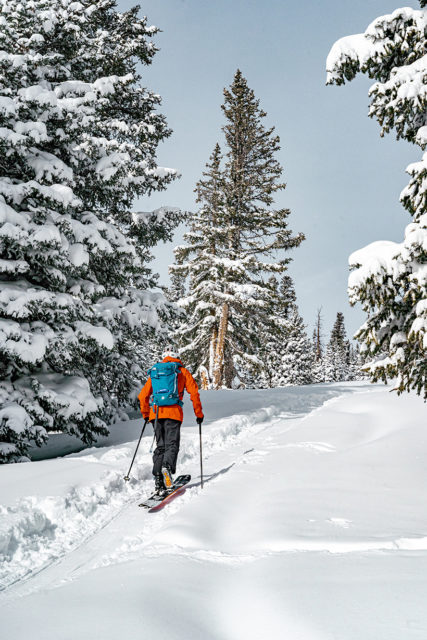
If you want the absolute lightest, there are lighter touring skis out there, but remember, what you give up in weight will pretty much always be noticeable on the downhill.
Luke Koppa (5’8”, 155 lbs): Yep, no complaints on my end when it comes to dragging the Backland 107 uphill. Only thing I’d add is that its low tail has worked just fine when it comes to stabbing it into the snow during transitions.
Powder / Soft Snow
Sam: I was fortunate enough to get the Backland 107 into some extremely deep snow this early season and the Backland 107 really feels at home in these conditions.
Bear in mind that this ski is only 107 mm underfoot, so take everything I’m about to write with that fact forefront in your mind. But for a 107 mm underfoot ski, the Backland 107 performs very well in deep snow.
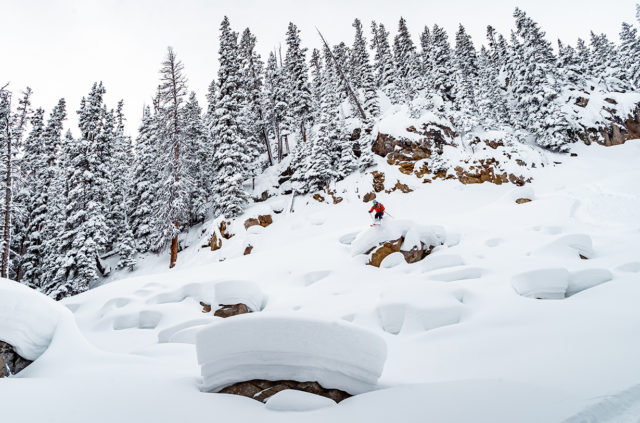
As I’ll talk about later in the review, the tail on the Backland is pretty stout and feels pretty locked into a turn in shallower conditions, but in deep snow, the tail is easy to release predictably and feels much less punishing than it does in firm and / or variable snow.
In deeper snow, the Backland 107 offers a distinct surfiness to it that is extremely fun. And I can’t help but attribute this (at least partially) to Atomic’s HRZN Tech tips. Yes, it seems like a complete marketing ploy. But after spending many days on the Atomic Bent Chetler 120, Bent Chetler 100, and now the Backland 107 (all of which feature HRZN Tech), I’ve come away with a fondness for their boat-hull-esque tips. They don’t have a massive impact on the way a ski feels, but I do think that these tip shapes contribute to a looser feel in powder than skis with “regular” tips. Let the debate rage in the comments.
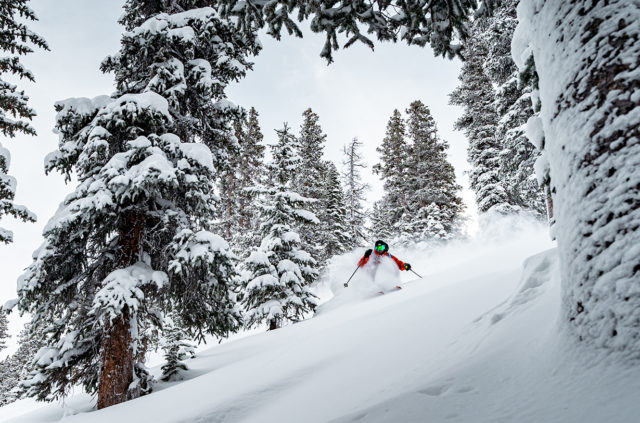
I could easily ski the Backland 107 as my dedicated pow touring ski here in Colorado, though on the deepest days, I’d be wanting more width for sure. But for a 107mm-wide ski, the Backland 107 is quite good in pow.
Luke: I was not fortunate enough to ski pow on the Backland 107, but everything Sam said seems reasonable, based on my time on the ski in some slushier conditions.
Soft Variable Snow
Sam: As I alluded to above, the Backland 107 is not the most forgiving ski in this category. The sweet spot on the ski is relatively small and the tail is not as forgiving as the hand flex would make it seem. Nowhere is this more noticeable than in variable snow.
When the snow isn’t consistent and predictable, the Backland 107 feels a bit punishing and unpredictable. I often want to ski from a neutral stance in weird snow to avoid punching through some soft snow and tomahawking, but the Backland 107 definitely feels a bit out of place when skied from a centered stance.
However, especially in the backcountry, I’m generally hesitant to drive my skis hard in variable snow. In variable snow (which is the majority of the snow I end up skiing in the backcountry), I found myself wishing I was on a different, more forgiving ski.
Luke: Yep, I totally agree. Despite not feeling that stiff when hand-flexing it, I was very surprised by how strong the Backland 107’s tail felt. This is a ski that definitely feels best when skied with a forward, driving stance. If I did that, the Backland felt like a pretty powerful ski. But as soon as I got off the shovels and onto the tails, I felt like I was losing control.
That strong tail will be a theme in this review, so I think it’s worth noting now that Sam and I have both been very comfortable skiing skis that are much longer, heavier, and / or stiffer than the 182 cm Backland 107. I’m far from the most technically perfect skier out there, but if you often end up skiing backseat (which, like Sam, I end up doing often in varying backcountry conditions), this will be an important thing to keep in mind.
We’re planning on having reviewers Eric Freson and / or Drew Kelly try the Backland 107 since they’re both more aggressive skiers than I am, and I’m very curious to hear their thoughts on this aspect of the ski.
Firm Snow
Sam: On firm snow, I actually quite like the Backland 107, as long as the snow is pretty consistent. If it isn’t consistent, then the ski feels punishing and unforgiving like it does in variable snow.
But if the snow is pretty consistent, the Backland 107 has a pretty good suspension and holds a strong edge. Because it likes being driven so much, it excels in firm and consistent snow where I can do the work of keeping the ski on line that a ski as light as the Backland 107 has trouble doing on its own.
If you don’t mind the weight for longer tours and peaks, I think the Backland 107 would make for a pretty good (wide) ski mountaineering ski. I would happily make exposed jump turns in firm snow on this ski.
Luke: Yep, on conditions like chalk, windbuff, and other smooth-ish firm snow, the Backland 107 is great. Stay over the front, and the ski rewards you with a pretty damp and stable feel for its weight, and it feels surprisingly solid on edge for how much tip rocker and taper it has. For making big, fast turns down smooth, firm snow, I’d say the Backland 107 is one of the better touring skis I’ve used in this weight class.
But in weird, rough, firm snow like sastrugi or summer suncups, the Backland 107 became pretty difficult to ski. In those conditions, I’m prone to reverting to a centered or backseat stance, and the Backland 107 doesn’t like that.
Trees, Steeps, & Tight Terrain
Luke: In any condition, the Backland 107 is pretty maneuverable as long as you stay over its shovels. As Sam noted, this is less important in powder where the ski feels looser / surfier, but on anything remotely firm, I found myself really needing to drive the front of the Backland 107 in order to get its tail to release.
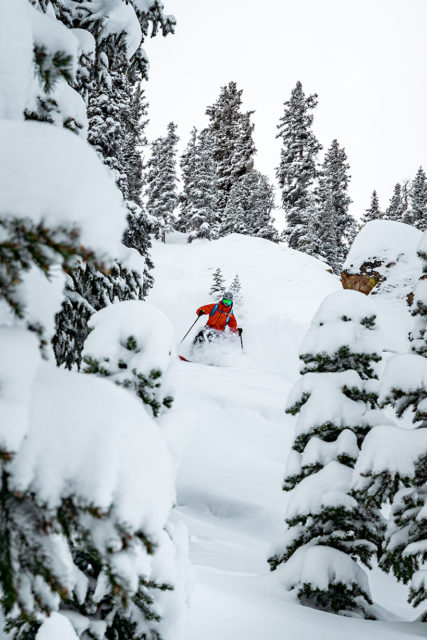
This was surprising since the Backland 107 still has a pretty tapered tail, but trying to pivot it from the backseat was quite challenging. But for skiers with good technique, I think the Backland 107 is pretty maneuverable.
Is it a Backcountry Charger?
Sam: I think the Backland 107 definitely falls on the “chargier” end of the spectrum than most of the touring skis on the market right now. It feels best when it is being pushed hard and skied from an aggressive, driving, forward stance. Beginners and intermediates stay away, neutral-stance skiers stay away, and if you tend to get lazy when ski touring and occasionally get back seat, there are many more forgiving options out there.
However, if a more game-on backcountry ski sounds appealing to you, then the Backland 107 is probably worth considering.
Luke: It’s funny, I never thought of the Backland 107 as a “backcountry charger,” though I also didn’t get to ski it super fast due to the conditions. So I’m not sure I agree with Sam here, mostly because of the Backland 107’s soft tips and shovels.
That said, I never once felt like I was folding the tips of the Backland 107. But I’m not a big guy nor the most aggressive backcountry skier, so this is another area where I’m curious to hear Eric Freson and Drew Kelly’s thoughts. But I definitely agree with Sam in that the Backland 107 encourages an aggressive, forward stance, which could make it a good option for those who find other touring skis to feel too soft in the tail or too inclined to make casual turns from a centered / neutral stance. And to be clear — this ski still only weighs ~1650 grams per ski for the 182 cm version, so the “backcountry” part of the “backcountry charger” name is very important. This is not some damp, super stable inbounds ski, and I personally would never want to ski it in the resort. I’d personally prefer a much more damp, heavy, and forgiving ski in the resort. But for skiing fast in the backcountry — especially in soft snow — the Backland 107 feels at home.
Who’s It For?
Sam: If you’re looking for a strong, mid-fat touring ski, have strong technique, and like to ski the backcountry like a resort (in other words, ski hard), then I think the Backland 107 is worth a look.
It is also worth considering if you’re an advanced or expert backcountry skier looking for a ski that you can use for a bit of everything, including ski-mountaineering (as long as you don’t mind the added weight or width of the Backland 107).
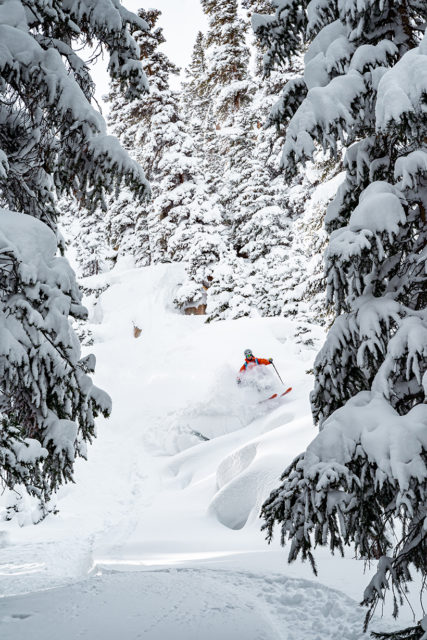
Luke: I definitely agree with Sam’s first paragraph. Beginners and intermediates have more forgiving touring skis to pick from (see the “Backcountry Touring Skis” section of our 19/20 Winter Buyer’s Guide). But for those with good technique, the Backland 107 is a pretty versatile and strong touring ski that can handle a bit of everything, provided you don’t mind / you like / you want its stronger tail.
As for ski-mountaineering, if you’re looking for a dedicated ski-mo ski, I’d suggest something much narrower. But if you’re like Sam and you ski everything from deep pow to steep lines in the spring and want one ski for all of that, then the Backland 107 is a solid choice.
Bottom Line
Atomic replaced the very playful Backland FR 109 with a very different ski — the Backland 107. It’s a ski that responds best to the strong input of a skilled pilot but rewards with strength, precision on firm snow, and a surprisingly surfy feel in deep snow.
Deep Dive Comparisons
Become a Blister Member or Deep Dive subscriber to check out our Deep Dive comparisons of the Backland 107 to see how it compares to the Black Diamond Helio 105, Blizzard Zero G 105, K2 Wayback 106, Line Vision 108, Ampler Facelift 108, G3 FINDr 102, 4FRNT Raven, & Moment Wildcat Tour 108.

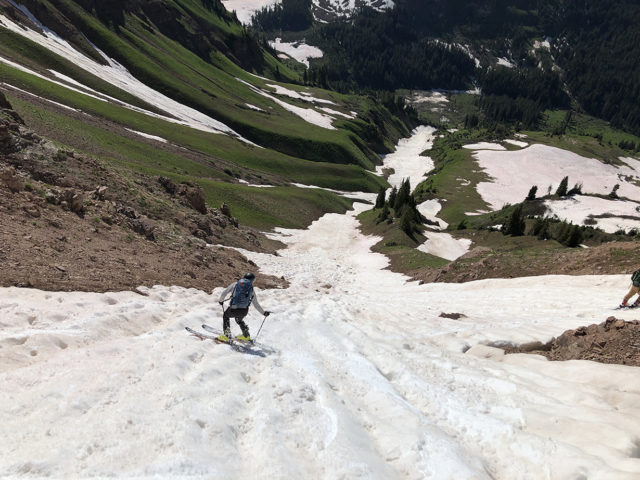
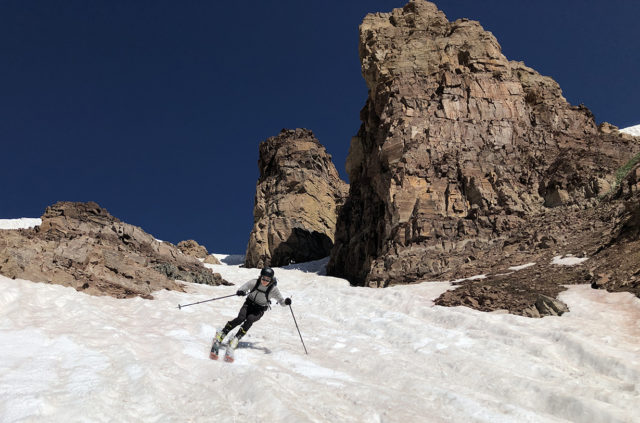
My pair of 18/19 are 1490 g heavy in 182 cm, verified.
hi!
im skiing on an atomic automatic 109 175cm and im in love with this ski, specialy in short and quick turns i need when skiing in the woods… is the backland 107 similar to ski or which ski would you recomend if i want a ski that is similar to the old automatic 109?
it should be also suitable for touring, it means i don’t need a pure touring skis which is super light, but a ski like the actual one, would be more than ok
thanks
alessandro
Iim on Backland 95s. Super light, decent on hard snow and dreamy in powder. Very impressive skis.
I agree. It’s great in soft snow and doable on hard snow. Why these guys would want >107 for anything is beyond me. Maybe if somebody else was skiing them uphill for me, by ~95 underfoot is a great all a rounder, IMO.
My 18/19 version in 182cm is also closer to 1500g per ski. Don’t remember exactly and now they have bindings on them. I remember them being almost identical weight to my old Helios.
Chris- I’d love to hear your thoughts on the backland 107s vs the helio 105s. I’m searching for an everyday touring ski and these two are topping the list right now. Thanks!
I absolutely love my Backland 109’s w Kingpins. Interested to give these skis a shot — looks like a very different ski than the 109. Do you guys plan to review the Backland 117? Seems like a ski that would be on your radar.
Pretty interested in comparisons between this, the Bent Chetler 100 and the 4FRNT Raven. With the width and the weight savings, I reckon that this will be the most soft snow orientated, but how well does it do on crappy snow? How about compared to these two? Do you sacrifice too much chop/hard snow performance when going lighter?
I sold by Ravens 184 and bought the backland 107 (189) for this year. Couldn’t be happier with the change. Even though the atomics are longer, they turn much quicker for me. Much more dialed in and more surfy in the soft snow, while having more power in a turn. I really dislike the more progressive center ish mounted skis, so i could never really jive with the raven (-6cm i think vs 10 ish on the backland). If you are a more directional skier who likes a more traditional mount – backland no question. If you like them more centered…then maybe the raven, not sure. I didn’t like them at all.
Did you guys mess around with different mount points and find ones you liked or was the recommended the best mount point you tried?
Very interested in comparison between K2 Wayback 106, Backland 107 and Helio 105. I am decided between these three for dedicated touring ski. Can you provide a quick overview?
Thoughts on the Backland 117 w Tectons for pow days in the Wasatch? Anyone have them setup for freeride touring?
If you’re skiing bigger faces I would absolutely recommend them. The slimmer versions of the backland, ie 107, 109 are quicker to respond in tighter spots, but they still feel less agile than other skis. The backland series excels on long turns, swoopy skiing, and free flying cliff drops. I loved the 107s ripping in a foot of powder at Alta! I know this response is two years late, but hopefully someone else is interested as well
Is the 2019-2020 Backland 107 the same as last years model (red/black top sheet) or are there significant changes? Dims, weight, etc…
According to Atomic, the 19/20 version of the Backland 107 is the same as the 18/19 version, apart from the graphics.
Did you manage to get some time on these skis, very eager to find out what you think?
My 2018-2019 Backland 107s delaminated and we’re replaced by Atomic with the 2019-2020 version. I don’t have the weights in front of me, but this years is a fair bit heavier – on the order of 100 grams per ski.
I’ve skied these and the BD Helio 105 extensively, although purely in backcountry snow. The Helio is a great ski, but has more of a utilitarian feel. It’s not as exciting but it skis everything well given it’s light weight. It would be a better choice for ski mountaineering type conditions (firm, variable). It has the feel of a lightweight carbon ski.
The Backland 107 feels beefier and heavier – which it is. Less of a lightweight carbon feel and more of a “real ski” feel. It’s certainly more playful and fun in powder than the Helio – it feels more oriented towards soft snow conditions and powder skiing. I’ve had a little harder time driving it with super light boots than the Helio.
Thanks for the feedback! Did you get an impression of the Backlands in tight spaces, like trees etc?
Can you guys please do a full review of the ON3P billy goat
How did you guys mount the 182’s? I have the 189’s at recommended and I feel like I can still come back a few cm’s. Thanks
Hey Matt, we have our pair mounted on the recommended line. I never felt the need to move the mount point, but I’m not all that sensitive to mount point in general. At -9 cm, the recommended mount is quite traditional already so I’d be reluctant to go back, but it could give you a bit more float.
I have skied the 107 a lot in deep powder, corn and crud. Love this ski. It is a great single quiver touring ski. It is an excellent powder ski in deep snow for a 107. We have skied this ski in 2-4 ft of powder on over 30 occasions and there is something about the tips that make it really fun. We have also put in many days on firm and corn and it is a high performance carver. My son is a collegiate ski racer and has the 182’s and can arc these in big GS turns. They hold nicely on steep lines and on dicey skin tracks. They may not be as playful as other skis but for touring we really like the combination of performance on powder and firm conditions. BTW, I have never skied an Atomic ski before so don’t have any affiliation or reason to promote them.
My pair of 19/20 are 1510 g heavy in 175 cm. If you were thinking to save some weight by getting one size less, do not make it.
Why not?
I had a pair of the 18/19 Backland 107 is 175 cm length but they are going to be retired to greener pastures. I plan to replace them with the 19/20 Backland 107s but I am having a hard time deciding between 175 cm and 182 cm. I have been skiing for 30+ years and would consider myself a skilled/agressive skier. I liked the 175cm but am wondering if I would like the 182 cm more. Any insight is appreciated. Best.
I have the 18/19 Backland 107s in 189. They weigh 1602 and 1609 g. I live in Hokkaido so I ski mostly powder, usually pretty deep. I had tested them for Backcountry Magazine in 182 mounted for AT. But I am a tele skier and thought the 182 skied great though they felt a little short for the length and very playful. Still, they were my favorite skis in the test. So I bought 189s. I mounted them boot center and had a surprisingly hard time finding my sweet spot on them. The tips seemed really far out there. I do ski in soft boots so my ability to drive tip pressure is a lot less than it would be if I were mounted with a locked heel. After a few days I decided to remount at +2 (with inserts on both mounts) and that made all the difference for me. They do get smacked around a little in lumpy, hard conditions. But that’s not what I bought them for and I don’t encounter that much here. They are a great daily driver for Hokkaido. I haven’t taken my 122 mm SkiLogik Bomb Squads out once since mounting these up. The weight savings on the up is too nice to give up. And they really don’t fall very short of the Bomb Squads’ powder performance in all but the deepest snow, and then they are still great. To answer a question I saw above, they are still impressively maneuverable in tight places and deep snow despite the length. I can’t keep up with the strongest alpine skiers I know in steep, complex terrain. But everywhere else that is not bordering on extreme they are as easy to ski fast as anything else. FWIW, I am 64 years old and a bit lazy when I’m trying to conserve energy. But I have been backcountry skiing for close to 50 years and I enjoy these skis as much as any ski I’ve ever had. Not the best in any one category but very capable in many.
I have the 18/19 107 red pair. Mounted 12mm back of factory recommended so it is easy to drive the tip. This ski is more cambered then the 19/20 version but I would believe the same construction. Hand flex the older version feels the same stiffness but I think it skis stiffer due to the additional camber.
The explosive pop out of a powder turn is second to none if there is a little density to the snow. I ski powder 95% of the time and I like how versatile it is.
I have about 10 days on these skis in powder and mixed conditions and definitely agree with the review’s comments about needing to ski these with a more aggressive forward stance in mixed conditions, they are not at all forgiving if you get lazy or tired and get back on your skis. Otherwise a great all-around ski!
Did Eric or Drew ever end up getting on these? Would love to see that update!
Picked up a pair of the new 100’s and absolutely loved them for spring touring. My 188s come in at 1400g and can be skied shockingly hard considering that weight.
What length would you recommend, I am 67 kg / 177 cm, advanced skier, mainly touring with the ski? Thanks
Did you guys end up playing with any other mount points with the 107?
Thanks for the review. Considering getting a pair of these to replace my old Blog 185s which have been my favorite ski of all time. Mounted with Fritschi Freeride Pro bindings that have hundreds of days in the backcountry and inbounds. Demoing a pair on Monday. Will be interesting to see the difference. Any thoughts on the differences?
Hey – So let’s say someone bought this ski but ended up not digging the “always be closing” style that this ski needs to feel fun in the woods, when it isn’t blower. What would be some more forgiving options that still is considered an advanced skier ski?
DPS Pagoda Tour 106?
BD Helio 105?
“Somethingsweetidontknowabout 107”?
Hello there,
Are they suitable for tree skiing or tight places ?
Have a good day